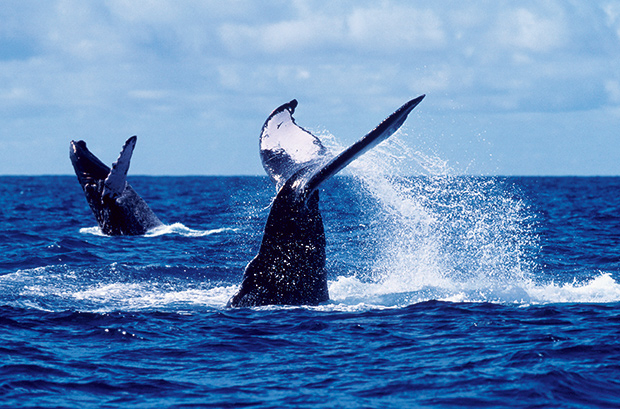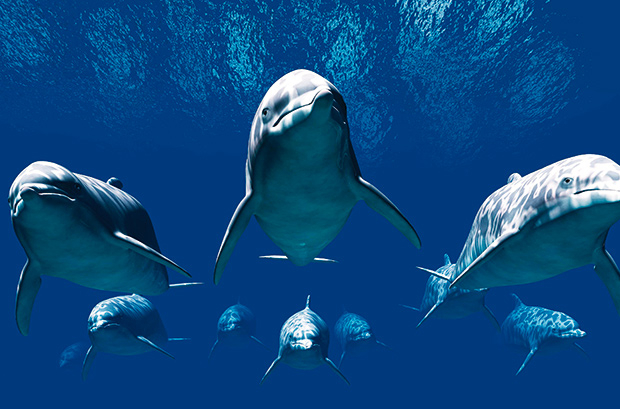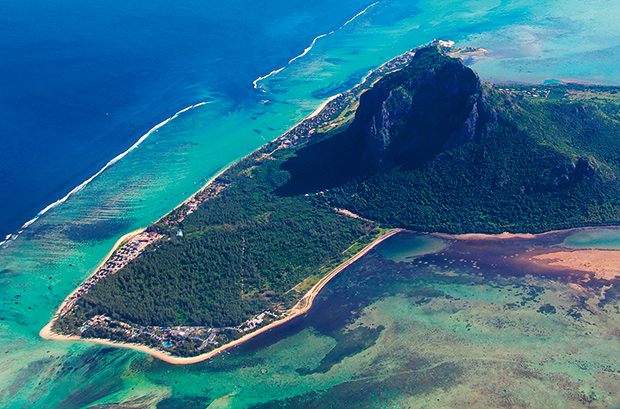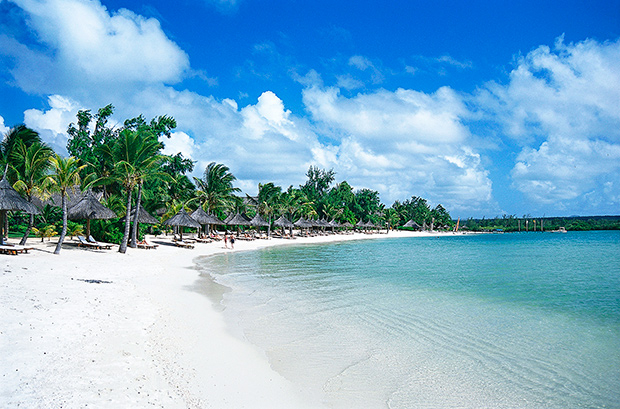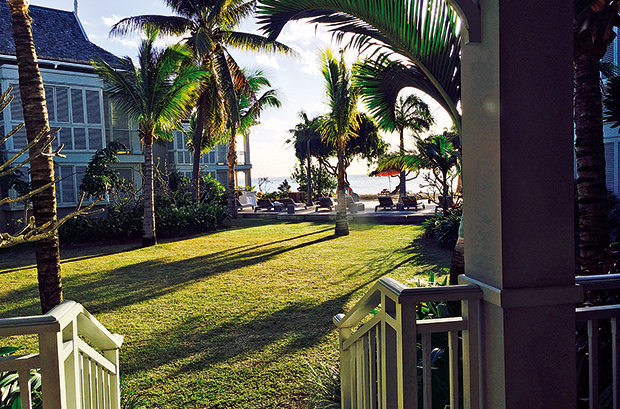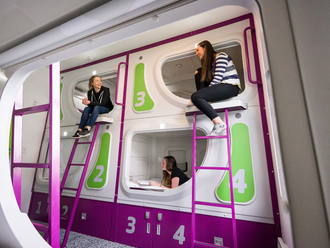
I’m perching precariously close to the propellers of a dormant speed boat, pulling on one flipper, and then clumsily fiddling with the second. Every now and then I glance up, an air of quiet anticipation rippling across the cluster of small boats and bobbing heads as my eyes dart across the surface of the Indian Ocean.
“They’ll come soon,” our skipper Marvin breathes, with the confidence of a seasoned expert. And so we wait.
We’re out at sea, about a 20-minute journey from The St Regis hotel, my new island home for the next few days – a sprawling five-star resort with 172 bedrooms and colonial style buildings nestled just behind the silver sands of Le Morne Beach on the south western tip of Mauritius.
While I ready myself for the main event – swimming with wild dolphins – a couple of other guests are sitting at the comfy end of the boat on white leather seats. They’re busy sprinkling croissant flakes on to their marshmallow soft robes, while sipping the coffee Marvin brought out for us in paper cups. It’s 7am. I wrestle with my snorkel mask. I’m not allowed to use the breathing tube attached.
“Too difficult for you out here,” Marvin warns. So it waggles redundantly in a breeze that’s picking up momentum. The water beneath looks deep. It’s almost black in fact, painted with strokes of navy and flecks of emerald green that sparkle in the day’s first bursts of sunlight. And it looks cold too.
But I push that thought to one side along with images of sharks and overly clingy seaweed. I’m about to leap into the ocean to swim alongside bottlenose dolphins. It’s bucket list gold. “I can eat pastries tomorrow morning,” I tell myself. And judging by the quick peek into the hotel’s Le Manoir dining room on my sleepy shuffle to the beach earlier, I will be spoilt for choice (there’s a entire juice room for crying out loud!).
Marvin is jigging about behind me. “Here they come,” he says, just as I stand up and yank the mask over my eyes. Squinting through steamy drips I see them. Neat grey fins, 10 of them, slicing through moody looking waves. People are pointing and jumping and beginning to swim really fast.
Marvin’s enthusiasm is infectious, as if it’s the first time he’s done this. It’s not. But he’s ramping up by the second. “Allez Allez!” he hollers. “Jump Judy, jump!” I’m not sure I’m ready. “I’m counting on you! JUMP!”
I breathe in and flop into the sea. Icy water grabs every inch of my body and squeezes. I don’t care though. I’m trying not to mouth ‘wow’ under water as the dolphins glide past – now about 10 metres from my flippered feet – in what’s called a ‘pod’. Further out you can get ‘super pods’ with up to one thousand dolphins travelling together, Marvin tells me later.
This little pod is enough for me. Dark grey on top, with a lighter belly, long snouts and that tell-tale dolphin smile. And there’s a baby one! It’s an incredible sight – like I’m witnessing a school run in the wild. Running out of puff, I burst to the surface.
I notice some stronger swimmers (who know their way around a snorkel mask) manage to get close enough to touch a fin or two. But Marvin says that takes practice.
I feel a little overwhelmed, but instantly want to go in again. Just then a man wearing a neon snorkel starts to gesture towards a patch of sea. “It’s our lucky day,” Marvin says, excitedly. More dolphins!
I spend an hour or so dunking and gawking at more passing dolphins until my fingers are wrinkly and I’m feeling the chill. I see why the St Regis hotel recommends this to their guests. And locals love it too. It’s a bit scary, a bit of a challenge – with visual keepsakes aplenty.
Keeping our distance from dry land, Marvin revs up the boat and we set off to our next stop – a catamaran we’ll meet out at sea close to Le Morne’s Black River Bay.
As we zip across the waves, I can barely take my eyes off the landscape around me. It’s a perfectly airbrushed backdrop – silky sun-kissed beaches (all of which are public) fringed with palm trees and cradled by turquoise waters. I almost expect to see the faint outline of a door on the horizon circa 1998 film The Truman Show. It looks too good to be true.
Le Morne’s Brabant Mountain looms to my left, jutting outwards and upwards like an oafish sleeping bear haloed in sunlight. It gained Unesco World Heritage status in 2008 after a five-year haul of applications. And once a hiding place for slaves (maroons) in the 18th century, it stands as a domineering beast harbouring secret caves, inaccessible cliffs and mysterious woods with a flat summit covering an area of more than 121,000 square metres.
It’s easy to understand why American writer Mark Twain spoke so highly about Mauritius after his 1896 visit: “Mauritius was made first, and then heaven, and that heaven was copied after Mauritius.”
While some say he was actually quoting an islander, either way it has been regurgitated by thousands of writers since to sum up the island’s natural, and largely unspoiled, beauty. Myself, now included.
And I’d only seen a glimpse of the scenery inland – waterfalls, meadows, and lush forests – on the hour-long journey from the airport to the hotel. Even better, this slice of paradise is only a six-and-a-half hour direct flight from Dubai and is in the same time zone so there’s no jet lag.
Marvin coaxes me out of my daydream by gently slowing the boat to a stop.
“Look ahead,” he whispers, stretching out his arm.
Following its line my eyes land upon a black shiny hump punctuated by a small pointy fin. And then another. “Humpbacks,” Marvin says quietly, as we chug into a bumpy cruise.
“Their tails are like a human finger print, each one is completely unique,” Marvin says, skilfully steering the boat closer to the whales – just as they flick their gigantic tails into the air and disappear under the surface. It really was our lucky day.
Wildlife is important to Mauritius. The Mauritian Wildlife Foundation (MWF), a non-government organisation, looks after the island’s endangered plant and animal species.
Mauritius was, after all, the only place the now extinct dodo bird was native.
It disappeared in the 17th century to be resurrected in fridge magnet form more recently, and is now the national symbol.
We arrive at our catamaran, which already has 15 tourists lounging on deck, sipping cool drinks, while a barbecue gently smokes. There’s something rather exhilarating about the idea of jumping off a speedboat on to a floating vessel, though the reality was more of a leap and a clamber.
With three men manning the barbecues it would clearly be a feast, and half an hour later we’re balancing paper plates piled high with juicy lamb chops, beef and chicken kebabs marinated in spices, honey, soy sauce and pieces of fresh salt fish – served on a heap of peppered white rice.
This island is big on flavours that pack a punch. This could be to do with the fact it is a multicultural melting pot of African (it’s 900km east of Madagascar), Indian, Chinese, Japanese and Arabic influences thanks to its hot-spot location in the Indian Ocean and chequered history.
A quick history lesson for you: Mauritius was uninhabited when the Dutch took possession in 1598, abandoned in 1710, taken over by the French in 1715 and seized by the British in 1810. The capital, Port Louis on the island’s north-western coast, was founded by the Dutch and named after the French king, Louis XV. The island gained independence from Britain in 1968, however the currency is neither the pound nor the euro, but the (Mauritian) rupee.
It’s hotchpotch population lives harmoniously (there are around 1.3million people, a third of who are Mauritian Creoles) and takes benefits from such international clout. The food being near the top of the list.
As I devour my first plate and ponder the idea of seconds I listen to easy waves of satisfied chatter in the local language – a French-based dialect that includes words from English, African and Asian languages.
“All the different influences make Mauritius a very interesting place,” muses Thierry, our dinner host at The St Regis resort. Thierry grew up in Mauritius and after moving to Europe and the States landed his dream job working at the hotel on home turf. “We’re a happy little island,” he says.
We’re dining at Floating Market – one of six restaurants at the resort. Surrounded by water it is named after the famous market in Thailand and serves up a South-Asian menu curated by Vietnamese born Chef Van Pham Thong.
A selection of very delicate, very pretty looking sushi arrives on a ring-shaped plate. “Bon appetit,” says Thierry. I ask him, “What’s the traditional dish of Mauritius?” He looks a bit stumped. By the time our Wagyu steak marinated in soy sauce (and as soft as warm butter) arrives he’s ready to explain there isn’t one dish – how can there be with such international input?
I take the short walk back to my bedroom – think private butler as standard, massive marbled bath, gigantic beds and spacious terrace – feeling rested, full and with a huge smile on my face.
The next evening after a relaxing snooze on the beach followed by a visit to the resort’s Iridium Spa for a full-body massage (the resort is all about shining a spotlight on health and wellness), I’m off to dine at Simply India, the resort’s flagship restaurant. Headed by Chef Atul Kochhar (the first Indian chef to receive a Michelin star, who has a restaurant in Dubai’s JW Marriott Marquis Hotel, too) the menu is full of gourmet treats. The biryani (Hyderabadi-style rice preparation with a choice of vegetable, chicken, lamb or seafood served in a pastry-topped pot) is incredible. And as a budding cook I want to try to recreate it at home.
Le Manoir Dining Room is all about celebrating classic French and Creole cooking, while the beachfront offers the perfect chance for a break from sunbathing in the form of a delicious signature burger at The Boathouse Grill, or something more active such as kitesurfing.
Mauritius is world famous among kitesurfing enthusiasts – Le Morne in particular, where expert riders travel from all over the world to tackle the world-famous ‘One Eye’ wave. The resort even has its own kite surf club (www.clubmistralprestige.com).
So on my last day on the island of course I decide to give it a go.
After a morning lounging by the hotel pool, a small boat takes me out to the stunningly beautiful turquoise lagoon (I’ve seen it all now) tucked around the corner and away from any curious beach goers. Standing in waist-high waters I’m taught how to control the kite, turning it from left to right without being dragged along the seabed. It’s difficult. And the thought of doing this on a moving board is quite a scary one. But my teacher Jason is encouraging, telling me, “It takes about five lessons to even get on the board.”
A two-hour group lesson costs 7,349 MUR (Dh844 including equipment), so you need to be keen to get that far. But I end my session feeling energised and vow to give it another go at Dubai’s Kite Beach.
That’s the thing, you’ll leave any beach holiday feeling relaxed. But with Mauritius I feel like I was allowed a taste of both the island and the wild.
This story first appeared on Friday in January 2015



